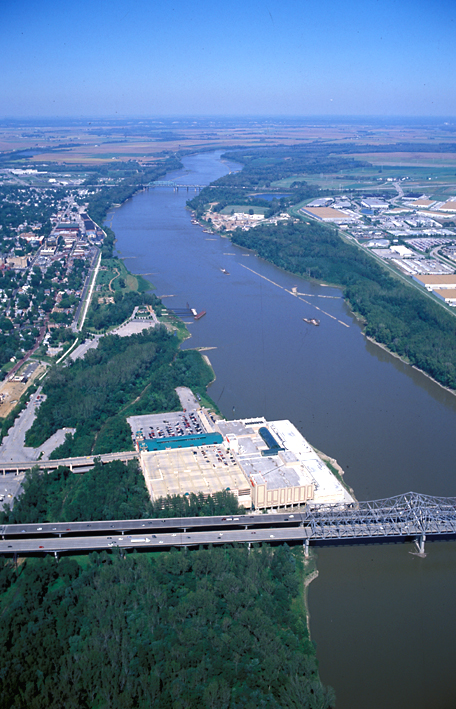Missouri River
View northeast, downstream
To see labels, point to the image.
© 2000 Airphoto—Jim Wark.
With Captain Clark in sole command, the Corps of Volunteers for North Western Discovery, as it was soon to be dubbed, left the mouth of Wood River at 4 P.M. on 14 May 1804. The flotilla was comprised of the barge and two pirogues (large rowboats), one painted red and the other white to distinguish them from afar, of six oars and seven oars, respectively.
Clark and the men “proceeded on under a jentle brease,” bound for St. Charles. Arriving there on the 16th, they had already learned two things. First, they must load each boat heavy in the bow to prevent it from riding up over snags and drifts. Second, they needed more manpower.
St. Charles was a single, mile-long main street with 100 dwellings, 450 “pore, polite & harmonious” inhabitants, and a chapel. The settlement occupied a narrow bench between the river and a range of small hills, hence its original French name, Les Petites Côtes, or “Little Hills.”
On Sunday, 20 May 1804, anticipating the dangerous mission, and perhaps desirous of all the divine help they could summon, Sergeant Ordway “and a nomber of the party went to the Mass.” As Pvt. Joseph Whitehouse wrote, the Roman Catholic service “was a novelty to them.” (see Church in St. Charles)
Captain Lewis arrived from St. Louis that afternoon, and the next morning the Corps set out in earnest, having gained two enlistees who would prove extremely valuable—interpreter François Labiche and river pilot Pierre Cruzatte. The expedition now comprised more than forty men—frontier soldiers, civilian employees, and perhaps a dozen French-Canadian hired hands, or engagés. They also had two horses for use by the hunters for hauling fresh meat to each night’s campsite.
After the expedition, Lewis himself intended to edit their journals for publication, but that plan never came to fruition. After many unexplained delays, Lewis died possibly by his own hand on 11 October 1809, at Grinder’s Stand (inn) on the Natchez Trace. In mid-March of 1810, Nicholas Biddle agreed to undertake the job of editing the two captains’ journals, and in April he met with Clark near Fincastle, Virginia to read through the manuscripts and discuss many of the questions his reading brought to his mind. The record he made of Clark’s responses to his queries contains many details of the journey that were not mentioned in the journals. Clark’s journal description of St. Charles in combination with Biddle’s notes from his 1810 interview with Clark[1]Donald Jackson, ed. Letters of the Lewis and Clark Expedition with Related Documents: 1783-1854, 2nd ed. (Urbana: University of Illinois Press, 1978), 2:507. resulted in this description that appeared in the Biddle’s 1814 edition of Lewis’s and Clark’s journals:
St. Charles is a small town on the north bank of the Missouri, about twenty-one miles from its confluence with the Mississippi. It is situated in a narrow plain, sufficiently high to protect it from the annual risings of the river in the month of June, and at the foot of a range of small hills, which have occasioned its being called Petite Cote, a name by which it is more known to the French than by that of St. Charles. One principal street, about a mile in length and running parallel with the river, divides the town, which is composed of nearly one hundred small wooden houses, besides a chapel. The inhabitants, about four hundred and fifty in number, are chiefly descendants from the French of Canada; and, in their manners, they unite all the careless gayety, and the amiable hospitality of the best times of France: yet, like most of their countrymen in America, they are but ill qualified for the rude life of a frontier; not that they are without talent, for they possess much natural genius and vivacity; nor that they are destitute of enterprize, for their hunting excursions are long, laborious, and hazardous: but their exertions are all desultory; their industry is without system, and without perseverance. The surrounding country, therefore, though rich, is not, in general, well cultivated; the inhabitants chiefly subsisting by hunting and trade with the Indians, and confine their culture to gardening, in which they excel.
Les Petites Côtes had been founded in 1765 by a French Canadian fur trader. In 1791 a Roman Catholic church was built there, and dedicated to San Carlos Borromeo—St. Charles of Borromeo. (That was the church most of the Corps of Discovery attended on Sunday morning, 20 May 1804.) The old town soon came to be known as San Carlos del Misuri, and soon just “St. Charles.” It was linked with St. Louis (founded as a trading post in 1764 by Auguste Chouteau), 19½ miles to the southeast, by the trail Meriwether Lewis followed to join Clark and the rest of the party at St. Charles on the afternoon of May 20. Once known as the St. Charles Rock Road, it still exists in part as a major route through northwest St. Louis County.
St. Charles was the first territorial capitol of Missouri, and the first state capitol from 1821 until 1826, when the state government was relocated to Jefferson City. The population of St. Charles as of the 2000 census was 60,321.
From Discovering Lewis & Clark from the Air
Photography by Jim Wark
Text by Joseph Mussulman
Reproduced by permission of Mountain Press
Today, the St. Charles Historic District is a High Potential Historic Site along the Lewis and Clark National Historic Trail managed by the U.S. National Park Service.—ed.
Notes
| ↑1 | Donald Jackson, ed. Letters of the Lewis and Clark Expedition with Related Documents: 1783-1854, 2nd ed. (Urbana: University of Illinois Press, 1978), 2:507. |
|---|



